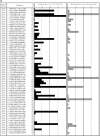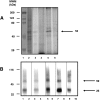Identifying Plasmodium falciparum cytoadherence-linked asexual protein 3 (CLAG 3) sequences that specifically bind to C32 cells and erythrocytes
- PMID: 15659379
- PMCID: PMC2253410
- DOI: 10.1110/ps.04883905
Identifying Plasmodium falciparum cytoadherence-linked asexual protein 3 (CLAG 3) sequences that specifically bind to C32 cells and erythrocytes
Abstract
Adhesion of mature asexual stage Plasmodium falciparum parasite-infected erythrocytes (iRBC) to the vascular endothelium is a critical event in the pathology of Plasmodium falciparum malaria. It has been suggested that the clag gene family is essential in cytoadherence to endothelial receptors. Primers used in PCR and RT-PCR assays allowed us to determine that the gene encoding CLAG 3 (GenBank accession no. NP_473155) is transcribed in the Plasmodium falciparum FCB2 strain. Western blot showed that antisera produced against polymerized synthetic peptides from this protein recognized a 142-kDa band in P. falciparum schizont lysate. Seventy-one 20-amino-acid-long nonoverlapping peptides, spanning the CLAG 3 (cytoadherence-linked asexual protein on chromosome 3) sequence were tested in C32 cell and erythrocyte binding assays. Twelve CLAG peptides specifically bound to C32 cells (which mainly express CD36) with high affinity, hereafter referred to as high-affinity binding peptides (HABPs). Five of them also bound to erythrocytes. HABP binding to C32 cells and erythrocytes was independent of peptide charge or peptide structure. Affinity constants were between 100 nM and 800 nM. Cross-linking and SDS-PAGE analysis allowed two erythrocyte binding proteins of around 26 kDa and 59 kDa to be identified, while proteins of around 53 kDa were identified as possible receptor sites for C-32 cells. The HABPs' role in Plasmodium falciparum invasion inhibition was determined. Such an approach analyzing various CLAG 3 regions may elucidate their functions and may help in the search for new antigens important for developing antimalarial vaccines.
Figures







Similar articles
-
Sequences of the Plasmodium falciparum cytoadherence-linked asexual protein 9 implicated in malaria parasite invasion to erythrocytes.Vaccine. 2010 Mar 19;28(14):2653-63. doi: 10.1016/j.vaccine.2010.01.004. Epub 2010 Jan 17. Vaccine. 2010. PMID: 20085836
-
Characterisation of Plasmodium falciparum RESA-like protein peptides that bind specifically to erythrocytes and inhibit invasion.Biol Chem. 2007 Jan;388(1):15-24. doi: 10.1515/BC.2007.002. Biol Chem. 2007. PMID: 17214545
-
CLAG 9 is located in the rhoptries of Plasmodium falciparum.Parasitol Res. 2004 May;93(1):64-7. doi: 10.1007/s00436-004-1098-4. Epub 2004 Apr 21. Parasitol Res. 2004. PMID: 15103554
-
The cytoadherence linked asexual gene family of Plasmodium falciparum: are there roles other than cytoadherence?Int J Parasitol. 1999 Jun;29(6):939-44. doi: 10.1016/s0020-7519(99)00046-6. Int J Parasitol. 1999. PMID: 10480731 Review.
-
Cytoadherence and sequestration in Plasmodium falciparum: defining the ties that bind.Microbes Infect. 2003 Aug;5(10):897-909. doi: 10.1016/s1286-4579(03)00162-x. Microbes Infect. 2003. PMID: 12919858 Review.
Cited by
-
Identifying putative Mycobacterium tuberculosis Rv2004c protein sequences that bind specifically to U937 macrophages and A549 epithelial cells.Protein Sci. 2005 Nov;14(11):2767-80. doi: 10.1110/ps.051592505. Epub 2005 Sep 30. Protein Sci. 2005. PMID: 16199660 Free PMC article.
-
Identification of Plasmodium falciparum RhopH3 protein peptides that specifically bind to erythrocytes and inhibit merozoite invasion.Protein Sci. 2008 Oct;17(10):1719-30. doi: 10.1110/ps.035923.108. Epub 2008 Jul 1. Protein Sci. 2008. PMID: 18593818 Free PMC article.
-
Complex nutrient channel phenotypes despite Mendelian inheritance in a Plasmodium falciparum genetic cross.PLoS Pathog. 2020 Feb 18;16(2):e1008363. doi: 10.1371/journal.ppat.1008363. eCollection 2020 Feb. PLoS Pathog. 2020. PMID: 32069335 Free PMC article.
-
A large scale Plasmodium vivax- Saimiri boliviensis trophozoite-schizont transition proteome.PLoS One. 2017 Aug 22;12(8):e0182561. doi: 10.1371/journal.pone.0182561. eCollection 2017. PLoS One. 2017. PMID: 28829774 Free PMC article.
-
Why do malaria parasites increase host erythrocyte permeability?Trends Parasitol. 2014 Mar;30(3):151-9. doi: 10.1016/j.pt.2014.01.003. Epub 2014 Feb 5. Trends Parasitol. 2014. PMID: 24507014 Free PMC article. Review.
References
-
- Alba, M.P., Salazar, L.M., Purmova, J., Vanegas, M., Rodriguez, R., and Patarroyo, M.E. 2004a. Induction and displacement of an helix in the 6725 SERA peptide analogue confers protection against P. falciparum malaria. Vaccine 221281–1289. - PubMed
-
- Alba, M.P., Salazar, L.M., Vargas, L.E., Trujillo, M., Lopez, Y., and Patarroyo, M.E. 2004b. Modifying RESA protein peptide 6671 to fit into HLA-DR-beta1* pockets induces protection against malaria. Biochem. Biophys. Res. Commun 15 1154–1164. - PubMed
-
- Bermudez, A., Cifuentes, G., Guzman, F., Salazar, L.M., and Patarroyo, M.E. 2003. Immunogenicity and protectivity of Plasmodium falciparum EBA-175 peptide and its analog is associated with α-helical region shortening and displacement. Biol. Chem. 384 1443–1450. - PubMed
-
- Bowman, S., Lawson, D., Basham Brown, D., Chillingworth, T., Churcher, C.M., Craig, A., Davies, R.M., Devlin, K., Feltwell, T., Gentles, S., et al. 1999. The complete nucleotide sequence of chromosome 3 of Plasmodium falciparum. Nature 400 532–538. - PubMed
Publication types
MeSH terms
Substances
LinkOut - more resources
Full Text Sources
Molecular Biology Databases
Miscellaneous

